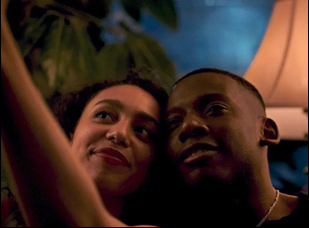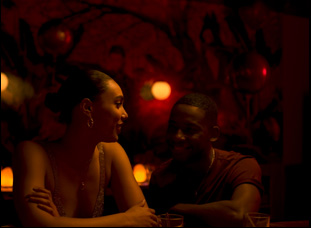“Aspirin should tide you over,” a dental assistant tells Dezi (Thomas Antony Olajide) in “Learn to Swim,” though you think it probably won’t do him any good. He lives with the blues professionally as a jazz saxophonist, but the abscessed tooth that’s brought him in for a checkup when it’s complicated how he hits the right notes is only half as bad as the heartache he fears he’ll endure if he lets go once and for all of his relationship with Selma (Emma Ferreira), a tempestuous singer who has her way with him as she does with octaves and could blow up their entire group with a breakup. Olajide naturally came to mind to play the anguished musician, having starred in both Thyrone Tommy’s original short that the feature expands upon and his subsequent short “Mariner,” and for better or worse, he could’ve known that to feel the character’s agony, he wouldn’t entirely have to use his imagination.
“There’s a jaw piece he’s wearing for half the movie, so I’m always finding ways to put Tommy through a little bit of torture through the filmmaking process,” laughed the director, who had previously required Olajide to shave his head for “Mariner” when he played a naval recruit getting hazed.
While Dezi may get raked through the coals, both Tommys take audiences to the promised land in “Learn to Swim” as the saxophonist pushes through the pain, ruminating about loss while slowly coming to the realization that the world is passing him by. It isn’t difficult to understand why Dezi has trouble finding his way when it is easy to get lost in the seductive world of jazz clubs and late-night hangouts that Tommy so richly elicits in the character study, flowing more like one of the free improvisations that Dezi is occasionally called to play on stage than a typical tale of heartbreak as crescendos of how passionate what once was rise to the surface and the low notes still smolder like embers of a dying flame. There’s an intensity to the emotions that the director is able to summon with a savvy use of color and sound design, pulling one into Dezi’s headspace and for as anxious as he becomes, it’s a place that you won’t want to leave when what’s there is so vibrant and unexpected.
Following its premiere at the filmmakers’ hometown Toronto Film Festival, “Learn to Swim” is making its way out into world on Netflix via a release through ARRAY and recently Tommy spoke about how he found his groove on the film and opened up the room for the actors to find theirs, as well as working on the film’s evocative soundtrack and the value of shaking things up in the edit.
In 2017, myself and my co-writer Marni Von Dyk were attending the Canadian Film Centre, a residency program [where] they pair a writer with a director and you create a short exercise. We did this as a short, “Medicated for Peace” based off the idea of my own personal guilt and grief, but also a poem by Stevie Smith, “Not Waving but Drowning.” And when it was done, we realized we hadn’t quite explored all the feelings and experiences that we really wanted to, so when the opportunity came to turn it into a feature, we decided to pitch it.
When you say feelings specifically, it’s interesting because this would seem to attach itself to that rather than a more chronological structure. Was that something in mind from the start?
At least for me when you’re going through something such as feeling guilt or grief, it’s not linear. There’s days when you feel great, there’s days that you don’t. You think about the past, you think about good things, you think about horrible things and it moves and ebbs and flows, that nonlinear structure was always a part of the film. It’s something that came very, very early on and never left.
There were also a lot of deliberate choices in the transitions between past and present, how we shot a lot of the performances, so those all remained, but I worked with two great editors – Baun Mac and Shaun Rykiss, who were with us at the Canadian Film Centre back in 2017 and funny enough, when they made an assembly of the film originally, they also handed in their editors’ take on the film, which is something that normally editors wait a while before they position, where they had completely scrambled the film to try something different. Interestingly enough, a lot of the choices that were in that original scramble exist now in the final film. I’m really grateful for them and I think it’s something I’m going to continue to do on projects forward is taking that leap and breaking everything apart and seeing what you’ve got and going from there.

Yeah, it was a big part of this. I build really extensive playlists before I shoot any of the films, music[-oriented] or not, so coming into this, it was really integral that we understood what the sound of the band was, what the sound of the musicians were before going into shoot. I worked with Chester Hanson and Leland Whitty of BADBADNOTGOOD fame and Meagan De Lima and Tika and Casey MQ — all these great musicians that are locally based here in Toronto and we came together and figured out the soundtrack, so by the time we finished that, it acted as a second script almost as to what the film was going to be.
And when Emma [sent in] her audition tape, we had all the actors sing a song of their choice she sang Chavela Vargas’ take on “La Llorona” or “Paloma Negra” – one of those two and it had been on my playlist from the beginning, so to hear her sing that song and that take of it was so kismet. And when she came in and did her audition with Thomas, we knew right away that we had Selma.
Was Thomas in mind from the beginning since you worked with him on your short “Mariner”?
We did the [short] exercise with him, but when we went to write the film, Marni will say she was always thinking about Thomas, but for myself I will always keep the character very, very open. But it couldn’t have been anyone else. Thomas is an incredibly, incredibly talented human being and so it just made sense that we spoke about it and he plays a little bit of saxophone, so I was like ooh, let’s lean into that a bit and it just organically grew from there.
When you see the two of them together, does anything change your idea of what this could be?
What was really important in that relationship, obviously with Selma being Afro-Latina and Dezi being American, it was really about them both being very steadfast in who they are as human beings. They needed to be completely confident [and have] a level of arrogance in who they are and what they want, so they needed to be able to challenge each other and not have anyone give in. Emma does such a great job of doing that, especially with Thomas, who can be very, very intense on screen and it took such a long time to find somebody as great as Emma, but once we had the two of them, it felt genuine.

Yeah, my process a lot of times is allowing the actors to move in the space and my cinematographer Nick [Haight] and I think about what’s the best way to capture that movement and what’s the best place to be. Sometimes you move people around a little bit to get them to that right spot, but especially when for everyone in the film, it was their first feature film, you really want to give them the space to focus on the performance. There’s a lot of aspects to their characters as musicians and as the characters themselves, giving them that freedom and allowing me and Nick to capture it the way we did felt like a process that worked the best.
But Nick spend a lot of time thinking about [the environment] when we’re sitting down and breaking down the scripts and bringing in the production designer. I like to bring in everyone as early as possible and start having those conversations. Part of it, for example, Tracy’s apartment has these blue and gray walls and I was really inspired by Alexandra Sanguinetti, this amazing photographer who took these great pictures down in Argentina where they had all these distressed walls. Here in Toronto, the apartment walls are just [generally] these stark white walls, so we went in very, very early and decided we’re going to paint the walls and add this texture. It’s one of my favorite parts of the design of the film is our choice to do that.
One of my favorite inventions is the scene where you shoot through the lid of the record player, giving the scene this foggy look. How did that come about?
We searched and we were looking for different record players and it’s one of those things where you’re looking at them and someone lifts the lid and you’re looking through it and you’re going, “That’s kind of interesting. That’d be a nice texture to bring into this space, let’s just try it.” For me and Nick and also for Thomas because we’d worked together before on “Mariner” and because we’ve worked together on other projects, there was a sense coming into this that we really wanted to challenge ourselves. We really wanted to step outside whatever comforts we felt we had gained in our previous relationship or previous projects, so I feel like the great thing about us is we’re constantly pushing each other.
Was there a particularly challenging day on the set?
We were shooting during the pandemic, so every day on set seemed a little intense, but for [the cast], it was definitely different the days they had to perform [music]. The performance days were always interesting because of they have their character, but those days when they have to be musicians completely and stepping into that for them was always a bit challenging. Once we did it a few times and got into the groove, it was beautiful to see.
The sound design also pulls you into Dezi’s experience quite evocatively. What was that like to work on?
Yeah, sound is a huge part of my process and I worked with Urban Post here and it’s something I spend a lot of time on. It was a lot of searching for different sounds and recording different pieces, recording all the instruments individually and bringing it into this space. For me, all my films are about the human experience and playing with all the senses that are available to us.





